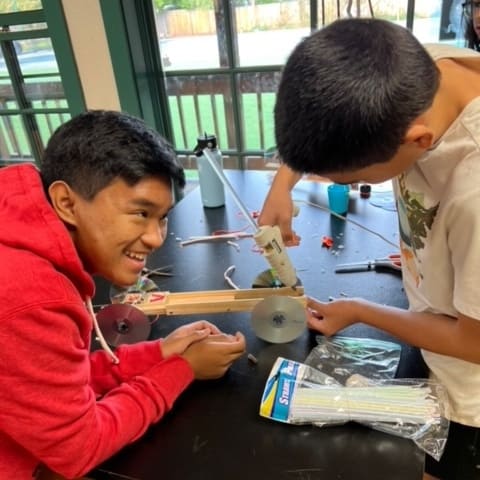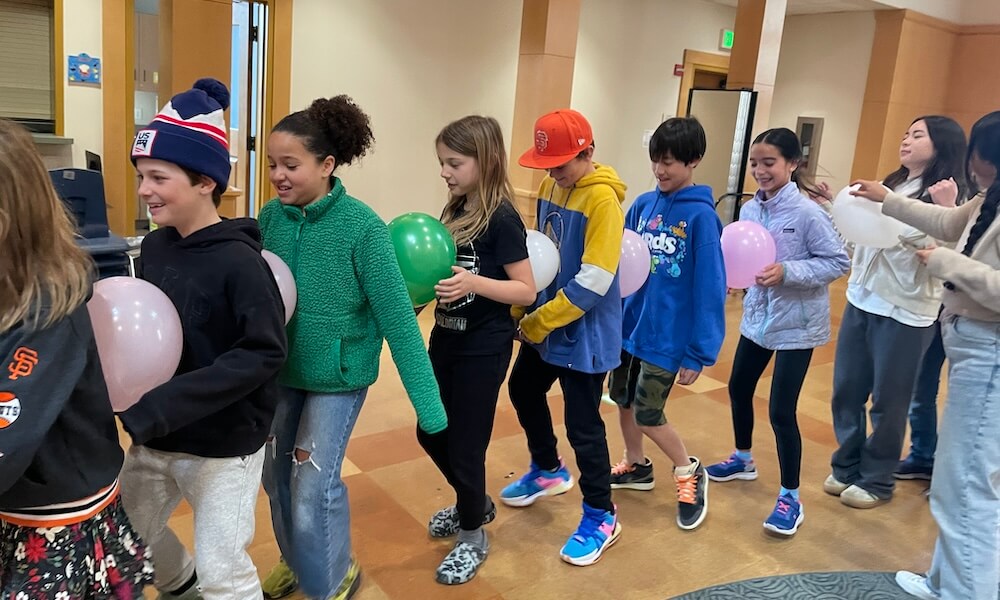Belonging and Well Being
Family Groups
In an effort to strengthen interpersonal connections within the school community and promote cross-grade interaction, Blue Oak established school "families." Each family comprises a minimum of two to four students from every grade level, TK through 8, accompanied by approximately four faculty or staff members. These family groups convene once or twice monthly, typically during Friday morning community meetings. The structured activities during these sessions are designed to foster self-confidence, cooperation, inclusivity, and communication skills among participants across various age groups. Students remain in their same family group for the duration of their time at Blue Oak.
Reading Buddies Program
The Reading Buddies program at Blue Oak is a well-established and long-standing tradition. Reading buddies are an opportunity for students across grade levels to come together around books. The frequency with which Blue Oak students read with their reading buddies varies by grade. Many students read with their buddies every week.
Reading Buddies program highlights literacy and offers students the opportunity to build their reading skills by offering fluent models, creating an authentic context, receiving one-on-one support and more. The Reading Buddies program also elevates our work as a school in a number of other ways.
Community building: Students meet other children outside of their grade level. Though it is uncommon in many schools, it is quite normal at Blue Oak to see children playing in a multi-age group. Games on the play yard typically consist of students from a variety of grades, with the older students often looking after the younger ones.
Leadership Development: Older students have the opportunity to mentor younger readers and strengthen their confidence as a reader and a friend. Younger students strengthen their confidence as readers while they read to the older students.
Empathy: Older students are called to consider what their younger buddy will understand and enjoy as they select books for reading buddies. Students connect to this empathy at other times, as well, like during recess play.
Middle School Advisories
Advisories in middle schools involve grouping students into smaller advisory groups led by a teacher or mentor. Students in the seventh and eighth grades at Blue Oak are in mixed-grade advisory groups, grouping students from different grades into advisories to support community building across the grades. For our sixth graders, advisory serves as an orientation class for the middle school in addition to social skill development.
Here’s a breakdown of how they work:
- Group Composition: Students are assigned to an advisory group. These groups may be intentionally mixed to encourage interaction and support across different age groups.
- Advisory Leader: Each advisory is led by a teacher who serves as an advisor or mentor to the group.
- Regular Meetings: Advisories meet every day during a designated advisory period. These meetings provide opportunities for students to connect with each other and their advisor, discuss relevant topics, and engage in activities aimed at promoting personal growth and development.
- Social and Emotional Support: One of the primary purposes of advisories is to provide social and emotional support to students. Advisors facilitate discussions and activities focused on building positive relationships, developing empathy and communication skills, managing emotions, and addressing common challenges faced by adolescents.
- Academic Monitoring: Advisors may also monitor students’ academic progress and provide guidance on study skills, organization, goal-setting, and academic planning. They may help students set academic goals, track their progress, and connect them with additional support resources if needed.
- Community Building: Advisories foster a sense of community within the school by bringing together students from different backgrounds and grade levels. Through collaborative activities, team-building exercises, and group projects, students develop a sense of belonging and connectedness with their peers and school community.
- Leadership Opportunities: Advisors provide opportunities for students to take on leadership roles within their advisory group, such as leading discussions, organizing events, or mentoring younger students. This encourages students to develop leadership skills, responsibility, and a sense of ownership over their learning environment.
Generally speaking, advisories in middle schools serve as a supportive and inclusive structure that promotes positive relationships, personal development, academic success, and a sense of belonging among students across different grade levels.
All of our middle school students participate in an advisory program with a specific curriculum meant to build community across the school.
Responsive Classroom
Responsive Classroom at Blue Oak School is an approach to teaching and learning that emphasizes the importance of creating a positive, inclusive, and engaging classroom environment. It is grounded in the belief that social, emotional, and academic development are interconnected and that fostering a sense of community and belonging is essential for student success. Here are key components of the Responsive Classroom approach:
- Morning Meeting: Each day typically begins with a Morning Meeting, during which students and teachers gather together to greet each other, share news or announcements, engage in a group activity or game, and participate in a brief academic or social-emotional learning component. Morning Meeting sets a positive tone for the day and helps build a sense of community within the classroom.
- Rules and Logical Consequences: Rather than a list of strict rules, Responsive Classroom emphasizes the development of a few positively stated, overarching expectations for behavior, such as respect and responsibility. Teachers work with students to collaboratively establish these expectations and discuss the logical consequences for not meeting them, focusing on learning from mistakes and making amends.
- Interactive Modeling: Teachers use interactive modeling to demonstrate desired behaviors and routines, actively involving students in the process. This approach helps students understand expectations and learn how to carry out tasks independently.
- Positive Teacher Language: Teachers use positive and proactive language to reinforce desired behaviors and encourage students’ efforts and progress. They provide specific feedback and praise to acknowledge students’ contributions and accomplishments.
- Classroom Organization: Classroom spaces are intentionally organized to promote active engagement, collaboration, and independence. Materials and resources are accessible to students, and the physical layout of the classroom supports various learning activities and group configurations.
- Academic Choice: Responsive Classroom provides opportunities for student choice and autonomy within the curriculum. Teachers offer meaningful choices related to topics of study, learning activities, and assessment methods, allowing students to pursue their interests and demonstrate their learning in ways that are personally meaningful to them.
- Guided Discovery: Teachers use guided discovery to introduce materials, tools, and classroom resources, allowing students to explore and discover their purpose and use. This approach promotes curiosity, problem-solving skills, and responsible behavior.
- Closing Circle: At the end of the day or a specific lesson, teachers often hold a Closing Circle, during which students reflect on their learning, share highlights or insights, and express gratitude or appreciation for their classmates and teacher. Closing Circle reinforces the sense of community and provides closure to the day’s activities.
Overall, Responsive Classroom is a comprehensive approach that integrates social, emotional, and academic learning to create a positive and supportive learning environment where all students can thrive.


